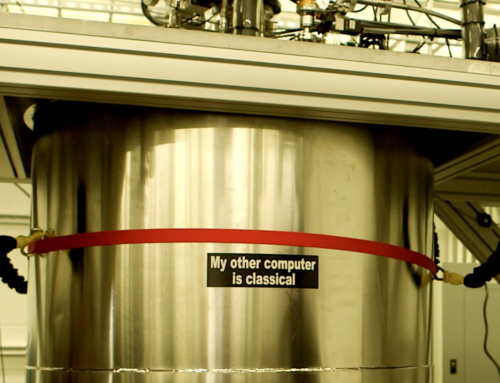Feature image via Nature
With news of Google’s possible achievement of quantum supremacy, quantum computing’s promise in a diversity of fields grows ever-more tangible. Drug discovery is just one of a number of areas in which quantum computing is expected to play a disruptive role. On average, it takes over ten years and billions of dollars to bring a potentially life-saving new drug to market. Quantum computers promise to revolutionize the currently expensive, difficult and lengthy process of drug discovery and development, by expanding the search for new chemicals to treat some of the world’s most deadly diseases, speeding up the creation of new drugs and cutting the costs of their development. At this prospective turning point in the advancement of quantum computing, Project Q takes stock of quantum applications in drug research and development.
Currently, researchers rely on computer models and simulations (M&S) to analyse how atoms and molecules behave, in order to develop drugs that will have optimal positive effects and minimal harmful ones. However, while of critical value to this process, today’s M&S tools quickly reach their limits of utility in the complex and computationally intensive process of molecular simulation. The goal of molecular simulation is to find a compound’s most stable configuration, known as its ground state. In order to do this, researchers use M&S systems to simulate the interactions between each of that compound’s electrons, in each atom, in order to test how they will react to one another. This is a fairly straight-forward task, as long as the molecules being tested are simple enough. However, even today’s most powerful supercomputers are only capable of simulating molecules of up to a few hundred atoms, limiting their calculations to only a small fraction of all chemicals that exist.
For a whole host of larger molecules that could be used to make new, life-saving drugs, researchers currently have no better option than to approximate how a molecule may react and then test its behaviour in trials. This process is incredibly inefficient and about ninety percent of drugs that do reach clinical trials fail during the first phase. Adding to this complexity, M&S methods are unable to calculate the quantum interactions that contribute to determining the characteristics of a molecule. A technological update in drug discovery is long-overdue.
Ultimately, the main technological limitation facing drug research and development today is that classical computers lack efficacy in what is known as optimization problems—finding the best solution by testing all feasible solutions—a process which is incredibly time and energy intensive. Quantum computers, in theory, are extremely good at optimization problems. This is due to their ability to leverage parallel states of quantum superposition, which enables them to model all possible outcomes of a problem at once, including the quantum interactions that happen on a particle-level. Theoretically, as they reach their promised computational capacity, quantum computers should be able to rapidly process mass amounts of data.
In 2017, IBM Q researchers achieved the most complex molecular simulation ever modelled on a quantum computer, proving the potential use-value for quantum computers in the pharmaceutical industry. The research suggests that if applied to drug discovery, quantum computers could model and test new drugs through molecular simulation far more comprehensively and much quicker than classical computers, effectively slashing the costs of novel drug research and development. Aside from empowering researchers to discover new treatments for a range of diseases, quantum computing could also help bring new drugs to trial more quickly and improve the safety of trials.
Already, innovators and researchers working on quantum applications in drug development are making waves in the pharmaceutical industry. Abhinav Kandala, part of the IBM Q team that simulated the largest molecule on a quantum computer back in 2017, has continued to push the boundaries of quantum computing in order to make it more applicable to industry, faster. His work focuses on a major challenge in quantum computing: improving accuracy. Quantum computers are still drastically error-prone in their current stage, hampering their utility for application in drug discovery and development. One of the MIT Technology Review’s 35 Innovators Under 35, Kandala has demonstrated how quantum errors can actually be harnessed in order to boost accuracy in quantum computations, regardless of the number of qubits. General advancements in quantum computing like this could help to bring the benefits of quantum computing to industry sooner.
There are number of young companies emerging in the pharmaceutical research space, looking at the computational boost and projected accuracy that quantum computing could lend to a range of challenges in diagnostics, personalised medicine and treatments. As quantum computers are not yet advanced enough to stand alone, most of these global start-ups rely on a blend of emerging and classical technologies. Especially prominent is the blended technological approach in machine learning and quantum computing, a topic we have previously explored here.
Another of the MIT Technology Review’s 35 Innovators Under 35, Noor Shaker leads a company that is harnessing these two e(merging)-technologies in order to speed up the creation of new medicines. Her company, GTN LTD, is producing technology that layers the processing power of quantum computing with machine learning algorithms to sort through mass amounts of chemical data in search of new molecules that could be used in disease treatment and prevention. Using this method, GTN (a Syrian female-run company) hopes to build a critical bridge in healthcare that could help to lessen the gap in access and quality of healthcare for people living in developing countries. GTN LTD’s application of these two technologies is just one example of the numerous ways in which they could be used to create and spread benefit across global healthcare systems.
Machine learning projects are already being implemented as part of a growing trend in digital healthcare, providing a helpful starting point for discussion of how other emerging technologies like quantum computing could also impact the sector. A recent article in Nature explores how even the most well-meaning of artificial intelligence (AI) applications in healthcare can lead to harmful outcomes for certain vulnerable sectors of society. The examples investigated by author Linda Nordling demonstrate the need to apply a careful social-impact and sustainability methodology throughout the process. As Nordling explains, many machine learning-based projects in healthcare can reinforce inequalities rather than help to level the playing field, if equity is not a factor that is thoroughly considered and addressed throughout the entire research and development process.
Of course, every technology is different. The challenges confronting AI applications in the healthcare sector may not translate directly to the risks that quantum computing could pose. However, there are certainly lessons to be learned. For all emerging technologies, there is equal potential to help lessen the gap between the rich and the poor as there is to widen it. The direction of development toward the helpful or the harmful hinges on many factors, including accountability and regulation. Fundamentally, the incorporation of a methodological focus on equity and inclusion, from the inception to the employment of an emerging technology, is critical.
The application of quantum computing in drug discovery is no exception to this rule. The development of this emerging technology, both alone and in concert with other technologies, has the potential to make a significantly positive impact on society. With proper care taken to ensure ethical research, development and application, the trickle-down effects of the quantum revolution could improve the lives of many. It is thus imperative that we seek to understand the impacts that quantum computing could have in the pharmaceutical industry if we want to ensure its potential to help discover cures to intractable diseases like cancer and Alzheimer’s becomes a benefit that is distributed equitably across the globe. This is not a problem for quantum to solve, but for society.







Leave a Reply